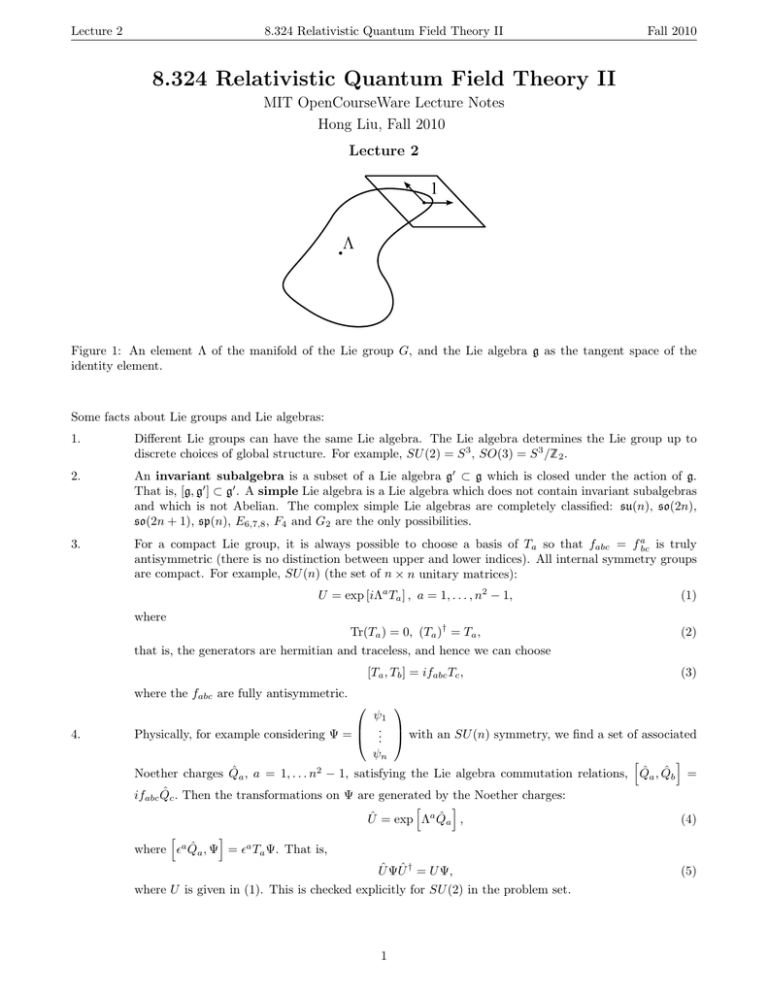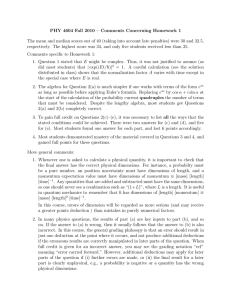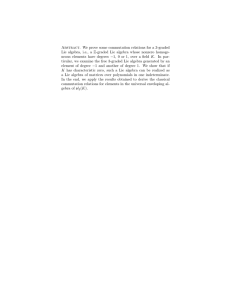Document 13650471
advertisement

Lecture 2 8.324 Relativistic Quantum Field Theory II Fall 2010 8.324 Relativistic Quantum Field Theory II MIT OpenCourseWare Lecture Notes Hong Liu, Fall 2010 Lecture 2 1 Λ Figure 1: An element Λ of the manifold of the Lie group G, and the Lie algebra g as the tangent space of the identity element. Some facts about Lie groups and Lie algebras: 1. Different Lie groups can have the same Lie algebra. The Lie algebra determines the Lie group up to discrete choices of global structure. For example, SU (2) = S 3 , SO(3) = S 3 /�2 . 2. An invariant subalgebra is a subset of a Lie algebra g′ � g which is closed under the action of g. That is, [g, g′ ] � g′ . A simple Lie algebra is a Lie algebra which does not contain invariant subalgebras and which is not Abelian. The complex simple Lie algebras are completely classified: su(n), so(2n), so(2n + 1), sp(n), E6,7,8 , F4 and G2 are the only possibilities. 3. For a compact Lie group, it is always possible to choose a basis of Ta so that fabc = f abc is truly antisymmetric (there is no distinction between upper and lower indices). All internal symmetry groups are compact. For example, SU (n) (the set of n × n unitary matrices): U = exp [iΛa Ta ] , a = 1, . . . , n2 − 1, (1) Tr(Ta ) = 0, (Ta )† = Ta , (2) where that is, the generators are hermitian and traceless, and hence we can choose [Ta , Tb ] = ifabc Tc , where the fabc are fully antisymmetric. 4. (3) ψ1 Physically, for example considering Ψ = ... with an SU (n) symmetry, we find a set of associated ψn [ ] 2 Noether charges Q̂a , a = 1, . . . n − 1, satisfying the Lie algebra commutation relations, Q̂a , Q̂b = ifabc Q̂c . Then the transformations on Ψ are generated by the Noether charges: [ ] Û = exp Λa Q̂a , [ ] where ϵa Q̂a , Ψ = ϵa Ta Ψ. That is, Û ΨÛ † = U Ψ, where U is given in (1). This is checked explicitly for SU (2) in the problem set. 1 (4) (5) Lecture 2 8.324 Relativistic Quantum Field Theory II Fall 2010 1.2: THE GAUGE PRINCIPLE (QUANTUM ELECTRODYNAMICS REVISITED) Referring back to the U (1) invariant Lagrangian we studied in lecture 1: L = −iψ(γ µ ∂µ − m)ψ, (6) which is symmetric under ψ(t, ⃗x) −� eiα ψ(t, ⃗x), we note that for the Lagrangian to be symmetric, it is necessary that α is not position-dependent. That is, all spacetime points transform in the same way. The transformation is no longer a symmetry for general α = α(x), that is, if we allow different phase rotations at different spacetime points. The mass term is invariant under these more general transformations. The kinetic term, however, transforms as ∂µ Ψ � ∂µ (eiα(x) Ψ(x)) = eiα(x) ∂µ (Ψ(x)) + i∂µ (α(x))eiα(x) Ψ(x), (7) where we have kept the x-dependence explicit. The second term is the problem. We want to construct a theory (i.e. a Lagrangian) which is invariant for a general α(x), that is, a theory with a local U (1) symmetry. The answer involves the introduction of a new vector field, and leads to quantum electrodynamics, as studied in 8.323. This example, in fact, embodies a deep principle: the principle of gauge invariance. As we will discuss, Local symmetries ≡ Interactions, Local U (1)symmetry ≡ Electromagnetic interaction, Local U (n)symmetries ≡ non-Abelian gauge interactions. To illustrate this principle, we will now “rederive” Quantum Electrodynamics from the requirement of local U (1) symmetry. We would like to construct a theory which is invariant under ψ(t, ⃗x) −� eiα(x) ψ(t, ⃗x), (8) for general α(x), also called a gauge transformation. An immediate consequence of (8) is that the ordinary derivative loses its physical meaning. Consider the derivative along some direction nµ : nµ ∂µ ψ = lim ϵ→0 ψ(x + ϵn) − ψ(x) . ϵ (9) If we can rotate ψ(x + ϵn) and ψ(x) independently, (9) does not have a definite meaning, as can be seen from the last term in (7). That is, it does not make sense to compare the value of ψ(x) at different points. So, to write down a sensible theory including kinetic terms for ψ, we need to introduce a new derivative, Dµ , such that: Dµ ψ(x) −� eiα(x) Dµ ψ(x). (10) To do this, assume we have an object U (y, x) that transforms under (8) as U (y, x) = eiα(y) U (y, x)e−iα(x) . (11) U (y, x) “transports” the gauge transformation from x −� y. y x Figure 2: The parallel transport U (y, x) transports the gauge transformation from x to y. That is, U (y, x)ψ(x) −� eiα(y) U (y, x)e−iα(x) eiα(x) ψ(x) = eiα(y) (U (y, x)ψ(x)), (12) transforming as ψ(y). Since ψ(y) and U (y, x)ψ(x) have the same transformation properties, ψ(y) − U (y, x)ψ(x) is well-defined. 2 Lecture 2 8.324 Relativistic Quantum Field Theory II Fall 2010 ψ(x + ϵn) − U (x + ϵn, x)ψ(x) . ϵ (13) Now take y = x + ϵn, and define nµ Dµ ψ = lim ϵ→0 By construction, Dµ ψ −� lim eiα(x+ϵn) Dµ ψ = eiα(x) Dµ ψ (14) L = −iψ(γ µ Dµ − m)ψ (15) ϵ→0 and is invariant under (8). We now want to construct U (y, x) explicitly. Since only local phase multiplication is a symmetry, U (y, x) should be a phase, as we don’t want to change other properties of ψ(x). We begin infinitesimally: U (x + ϵn, x) = 1 + iϵnµ eAµ (x) + . . . , (16) where e is a constant and Aµ (x) is a real vector field. Under the transformation (8), so that U (x + ϵn, x) −� eiα(x+ϵn) U (x + ϵn, x)e−iα(x) , (17) 1 + ieϵnµ Aµ (x) −� eiα(x) (1 + iϵnµ ∂µ α(x))(1 + ieϵnµ Aµ (x))e−iα(x) , (18) and hence 1 Aµ (x) −� Aµ (x) + ∂µ α(x). e Finally, we have for the covariant derivative Dµ : Dµ ψ = ∂µ ψ − ieAµ ψ = (∂µ − ieAµ )ψ. (19) (20) Inserting the transformation laws for Aµ (x) and ψ(x): (19) and (8), respectively, we have that Dµ ψ(x) transforms as ψ(x). We want Aµ (x) to be a dynamical field, and hence we require a kinetic term for this vector field, which should be invariant under (19). To construct this, we note that Dµ (Dν ψ) transforms as ψ, and so does (Dµ Dν − Dν Dµ )ψ, so we define [Dµ , Dν ] = [∂µ − ieAµ , ∂v − ieAν ] � −ieFµν , (21) Fµν � ∂µ Aν − ∂ν Aµ , and we have that Fµν ψ transforms as ψ, so that Fµν is invariant. 3 (22) MIT OpenCourseWare http://ocw.mit.edu 8.324 Relativistic Quantum Field Theory II Fall 2010 For information about citing these materials or our Terms of Use, visit: http://ocw.mit.edu/terms.



